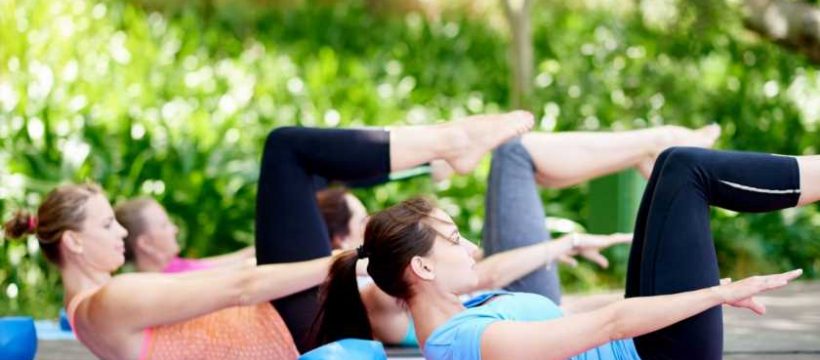Giving people options in pilates can make exercises easier or harder, depending on what level someone’s at. But many of us feel the pressure to jump straight to the most advanced options – and this is holding us back from improving, says pilates teacher Izzie Price.
As a pilates instructor, I often find it difficult to strike a balance in my classes. Some of my clients are very experienced and want to be challenged, while others might be dipping their toes into pilates for the first time.
One of the best things about pilates is that each exercise can be adapted or progressed, depending on someone’s individual needs. Adaptations make exercises slightly less intense (for example, you could adapt The 100s exercise – where you lie on the mat and beat your arms 100 times while keeping your head, shoulders and legs off the floor – by keeping your feet on the mat) and progressions take exercises up a notch (eg extending your legs out long during The 100s).
Adaptations and progressions are a real gift; they allow pilates to be a lifelong practice, whether you’ve taken a fitness break or got stronger. But the issue is that people often feel pressure to take on progressions when they’re not necessarily ready.
You may also like
Pilates core exercises to build stronger abdominals, glutes and back muscles
I’ve been there; when I was first getting into pilates, I’d feel compelled to ‘keep up’ or do what everyone else was doing. The result? Sore muscles and a noticeable dent in my self-esteem.
So it’s my role as the instructor to emphasise to my clients that it really doesn’t matter what anyone else is doing. It’s great to challenge yourself, but the most important thing in pilates is to take the option that feels best for you. The pressure can feel stifling, especially if everyone in the class seems to be breezing through those shoulder bridge progressions. But those modifications exist for a reason.
You need to nail the fundamentals first
‘Back to basics’ is a term we hear flung around a lot, but pilates really is all about the fundamentals. It’s crucial to make sure your alignment is right before you step up the intensity.
The ‘scissor’ exercise (keeping the legs lifted in a ‘table top’ position and tapping alternate sets of toes on the mat), for example, should be performed with the legs maintained at a strict right angle, rather than letting the toes take over and lead the movement. That’s hard – I really struggled with letting the movement ‘hinge from the hip’ at first.
Because form is so important, it’s much better to stick with the adapted version (one leg at a time), rather than progressing straight to moving both legs. It also takes practice (and increased abdominal strength) to keep the knees firmly over the hips, rather than letting them creep in towards the body.
You might risk injury
While pilates is generally an injury-preventing activity, pushing through the stages and jumping to the most advanced option before you’ve nailed the basics can result in pain. A pilates-induced injury can be a bit like a speeding ticket; we might think we can get away without one, but it’s totally avoidable if we just slow it down.
The last thing I’d want is for anyone to damage their bodies. If your body isn’t correctly aligned when you’re doing abdominal exercises on your back (if you don’t have a neutral spine, for example), there is a chance you could do more harm than good. Rushing up to the most progressed option won’t see as many benefits (if any) if you’re not properly aligned from the outset. Learning that alignment takes time.
Pilates should build confidence, not lower it
Don’t get me wrong – it’s important to challenge yourself, and we only get stronger by pushing ourselves and our bodies. But it’s important to challenge yourself when you’re feeling confident that you’re ready to take it up a notch, rather than because you’re worried you’ll be the only one not taking a progression.
It’s vital that we eliminate the pressure that sees an entire class of people holding themselves to the standards of the most experienced person in the room. I’d hate for anyone to leave one of my classes feeling deflated because they couldn’t master a progression as quickly as others seemed to.
Each body is unique
We’re all built differently. We all have different strengths and abilities, and we’ll all be affected by different external factors. If you didn’t sleep well, for example, that might impact your pilates practice in a way that won’t affect someone who got a full eight hours.
Don’t judge your body by anyone else’s standards. This is your workout; it doesn’t belong to the person two mats down or on the Zoom square next to yours. It doesn’t matter what they’re doing; it matters what your body needs. If you want to challenge yourself, that’s great, but make sure you’re doing it for yourself and not for the person next to you.
Pilates should be fun
OK, maybe ‘fun’ is an overstretch when you’re feeling the burn from your clamshell exercises, but ultimately, pilates should release plenty of endorphins and leave you feeling strong, uplifted and (even) happier than when you started.
Pilates is for everyone, no matter your strength or experience level, but if you judge yourself by others’ standards, the ‘fun’ element will disappear. No one should ever feel inadequate or ‘left behind’ in a pilates class. Honour your body and where you’re at in your pilates journey. Put yourself first, and you’ll be reaping the physical and mental benefits in no time.
Images: Getty
Source: Read Full Article
